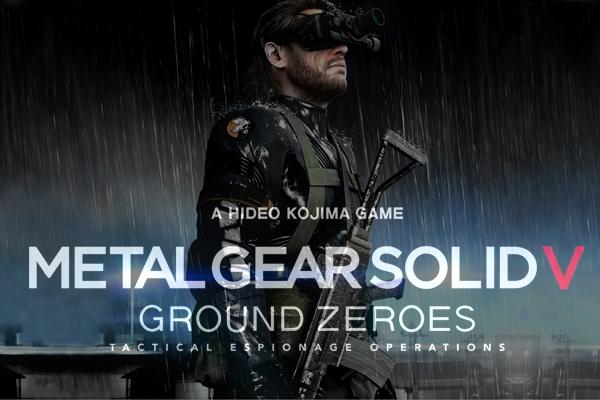Metal Gear Solid V: Ground Zeroes sneaks its way to the next level.
Initiating tactical espionage operations like it’s 1975.

April 30, 2014
Do you think that the Cold War wasn’t tense enough? Well then, try being the leader of a rogue mercenary group/private military contractor in possession of a bipedal walking tank armed with nuclear weapons in the middle of it all.
Metal Gear Solid V: Ground Zeroes is the eighth entry in the main Metal Gear series of action-adventure/stealth games developed by Kojima Productions.
In Ground Zeroes, you play as Snake, aka “Big Boss”, the greatest soldier who ever lived. He is tasked with infiltrating Camp Omega, a US military black site used for extraordinary rendition. While there, he must rescue two captives: Chico, a former child soldier and Paz, a double agent who betrayed Snake in the past, but has information that he needs.
While the only location in the game is Camp Omega, it is a very large area with much to explore. The camp houses several different sections such as an armory, barracks, and prisoner containment zone like one might typically find in a military black site like this. The size of the area feels even larger than it already is as there is no mini map on the screen like there has been in previous Metal Gear games. The map can still be accessed through the options menu, but it isn’t nearly as essential anymore, allowing the player to have a greater sense of independence.
In terms of graphics, Ground Zeroes is astounding. As one of the first games to utilize Kojima’s new Fox Engine, it demonstrates how far ahead of the game Kojima Productions is compared to other developers. It is a fantastic display of the Playstation 4’s graphical capabilities, pushing the limits of what a video game console can do. Simply put, this is the best looking game that I have ever experienced.
Along with phenomenal graphics, Ground Zeroes also offers game play of the highest caliber. It feels very similar to Metal Gear Solid 4, but with a heavy coat of polish for the newest generation of game consoles. If you’ve played MGS4, you would feel comfortable with Ground Zeroes almost immediately. This time around though, Kojima has vastly improved the gun mechanics which were one of the only weak points in previous games. While this makes the game feel that much better than previous installments, it might be something you don’t notice right away since stealth is usually a better option.
One of the biggest changes to the Metal Gear formula in Ground Zeroes has to be the voice acting. While most of the character roles are reprised by their original voice actors, the role of Snake is not. Up until now, the voice of Snake has been provided by David Hayter, whose gravelly voiced performance was one of the most contributing factors in making the character iconic. With the always improving technology in graphics design though, Kojima Productions wanted to recast the role so that the voice actor could also perform the motion-capture for Snake. This is the main reason why David Hayter was passed over in favor of the man who played 24’s Special Agent Jack Bauer, Kiefer Sutherland. While Hayter’s iconic portrayal will be missed, Sutherland actually does a pretty good job assuming the mantle of the greatest soldier who ever lived. It might take time for some fans to adjust to the new voice, but it will work out for the best. I won’t admit that Sutherland’s take is better than Hayter’s, but he brings something new to the table. Now, in addition to emotions coming through Snake’s voice, they can also come through his facial expression thanks to Sutherland’s motion-capture. This adds an extra layer of depth during cutscenes, so that dialogue isn’t always necessary to convey the mood of a situation.
Critically, the only downfall of Ground Zeroes is its length. Originally, the game was to be the opening sequence for Metal Gear Solid V: The Phantom Pain which is scheduled for release in 2015. At some point, Kojima decided to split MGSV into two parts, with the first part being released as a prologue to the second. This is where people tend to flare their opinions as Ground Zeroes (played at a normal pace) takes around two hours to beat. If you skip all the cutscenes and optional objectives, the game can supposedly be finished in ten minutes. Personally, it took almost three hours to get through and I only did the optional parts in passing. To address previous criticisms, the main “Ground Zeroes” mission is shorter than most people would have liked it to be. Here’s where the issue lies though. There is more to the game than the single mandatory mission you are given. As I stated before, there are optional tasks you can perform such as rescuing POWs and finding collectible items scattered around Camp Omega. Finding everything may require you to play the game multiple times, which is what you are supposed to do. To get more out of the game, you have to put more into the game. You are supposed to play the game multiple times. After playing the “Ground Zeroes” mission, you will unlock some Side Ops missions. These are additional missions within Camp Omega that have you executing different tasks than the main mission. For whatever reason, the Side Ops missions have been strangely absent from critiques of the game’s length. They are additional to the main portion of game play, so they should be treated as part of Ground Zeroes.
Due to the length of the game, the plot is relatively bare. Fans of the Metal Gear series will be able to recognize familiar characters and understand what’s going on from the previous game, Peace Walker, but newcomers will probably be confused. Ground Zeroes attempts to bring players up to date with a summary of the plot so far, which is a nice thing to do for newer players, but even die hard fans will admit that while Metal Gear’s story is entertaining, it has a long history of being convoluted by overly detailed explanations of itself and jarringly preposterous plot elements that contrast with its otherwise realistic nature. By being so short though, the plot never really gets the chance to let loose. Sure, the opening cutscene clocks in at somewhere around ten minutes, but that’s almost all the game offers to the player. With only one mission contributing to the over-arching story, there simply isn’t enough time for any absurdities. The ending is the only part of the game that could be counted as ridiculous, but it’s more of a, “Wait, is this actually happening?”, instead of the usual, “Only in a Kojima game.”
Overall, Ground Zeroes is an excellent addition to the Metal Gear series. While the length of the game may be an issue to some, it is more than made up for by the (quite literally) awesome visuals, fresh game play, and stellar voice acting. The only truly bad part of Ground Zeroes is the anticipation for The Phantom Pain that it makes you feel. Metal Gear Solid V: Ground Zeroes is a must play for Metal Gear fans, people new to the series, or anyone looking for a game to really kick off this newest generation of gaming.


